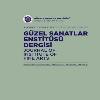Silika ile kuşelenmiş atık kâğıtların plastik kompozit üretiminde değerlendirilmesi
Utilization of silica coated waste paper fibre in plastic composite production
___
- Ardekani SM, Dehghani A, Al-Maadeed MA, Wahit MU, Hassan A (2014) Mechanical and thermal properties of recycled poly (ethylene composites. Fibers and Polymers (15):71531-1538 reinforced newspaper fiber
- Ashori A, Nourbakhsh A (2009) Mechanical behavior of agro-residue- reinforced polypropylene composites. Journal of Applied Polymer Science 111(5):2616-2620
- Banga H, Singh VK, Choudhary SK (2015) Fabrication and study of mechanical properties of bamboo fibre reinforced bio- composites. Innovative System Desing and Enginnering 6(1):84- 98
- Bledzki AK, Reihmane S, Gassan J (1998) Thermoplastics reinforced with wood fillers: A literature review. Polymer-Plastics Technology and Engineering 37(4):451-468
- Çavdar Dönmez A, Kalaycıoğlu H, Mengeloğlu F (2015) Technological properties of thermoplastic composites filled with fire retardant and tea mill waste fiber. Journal of Composite Materials doi: 10.1177/0021998315595113
- English B, Stark N, Clemans C (1997) Weight reduction: wood versus mineral filler in PP. 4th International Conference on Woodfiber- Plastic Composites, Madison, WI: Forest Products Society, 324, pp 237-244
- Faisal A, Salmah H (2012) Mechanical and thermal properties of compatibilized waste office white paper-filled low-density polyethylene composites. Journal of Thermoplastic Composite Materials 25(2):193-207
- Feng, J.M. The Application of Infrared Spectroscopy in the Analysis of Trace Evidence. Chemical Industry Press, Beijing, 2010
- Godara A, Raabe D, Bergmann I, Putz R, Müller U (2009) Influence of additives on the global mechanical behavior and the microscopic strain localization in wood reinforced polypropylene composites during tensile deformation investigated using digital image correlation. Composite Science and Technology 69:139-146
- Hadal RS, Dasari A, Rohrmann J, Misra RDK (2004) Effect of wollastonite and talc on the micromechanisms of tensile deformation in polypropylene composites. Materials Science and Engineering A 372(2):296-315
- Huuhilo T, Martikka O, Butylina S, K?rki T (2010a) Impact of mineral fillers to the moisture resistance of wood-plastic composites. Baltıc Forestry 16(1):126-131
- Huuhilo T, Martikka O, Butylina S, K?rki T (2010b) Mineral fillers for wood-plastic composites. Wood Material Science & Engineering 5(1):34-40
- Ismail SH, Bakar AA (2006) Effects of chemical modification of paper Sludge filled Polypropylene (PP)/Ethylene propylene diene terpolymer (EPDM) composites. Journal of Reinforced Plastics and Composites 25(1):43-58
- Martikka O, Huuhilo T, Butylina S, Kärki T (2010) The effect of mineral fillers on the thermal properties of wood-plastic composites. Wood Material Science & Engineering 7(2):107-114
- Mitchell J, Vandeperre L, Dvorak R, Kosior E, Tarverdi K, Cheeseman C (2014) Recycling disposable cups into paper plastic composites. Waste Management 34(11):2113-2119
- Panigrahy BS, Rana A, Chang P, Panigrahi S (2006) Overview of flax fiber reinforced thermoplastic composites. Canadian Biosystems Engineering Journal 06(165):1-12
- Sherman LM (2004) Wood-filled plastic they need the right additives for strength, good looks and long life. Plastic Technology 6(6):52- 59
- Souchy J, Koubaa A, Migneault S, Riedl B (2014) The potential of paper mill sludge for wood-plastic composites. Industrial Crops and Products (54):248-256
- Zhao, H., Hou, Q., Hong, Y., Liu, W., li, Y., Tony, F. Determination of Calcium carbonate and Styrene-butadiene Latex Content in the Coating Layer of Coated Paper Journal of Industrial and Engineering Chemistry 20 (4) 2014: pp. 1571-1576.
- ISSN: 2146-1880
- Yayın Aralığı: 2
- Başlangıç: 2000
- Yayıncı: Artvin Çoruh Üniversitesi Orman Fakültesi
Mehmet AKYÜZ, Yasemin GÜRHAN, Burak BIRCAN, Sevda KIRBAĞ
Türkiye liken biyotasına katkılar
Aydın KAHRİMAN, Gökberkhan KUMAŞ
Silika ile kuşelenmiş atık kâğıtların plastik kompozit üretiminde değerlendirilmesi
Enzimatik muamele ile doğu ladini (Picea orientalis l.) diri odununun geçirgenliğinin arttırılması
Ümit Cafer YILDIZ, Sefa DURMAZ
Çay (Camellia sinensis) alanlarının peyzaj değeri
Dactylorhiza urvileana'nın in vitro asimbiyotik çimlendirilmesi ve fidelerinin oluşturulması
İran bahçe sanatının ve tasarım özelliklerinin araştırılması
